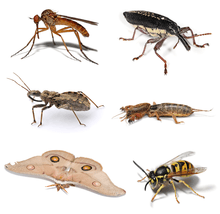Limenitis arthemis
| Red-spotted purple White admiral | |
|---|---|
| L. a. astyanax | |
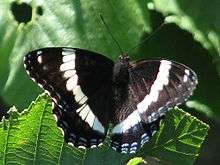 | |
| L. a. arthemis | |
Not evaluated (IUCN 3.1) | |
| Scientific classification | |
| Kingdom: | Animalia |
| Phylum: | Arthropoda |
| Class: | Insecta |
| Order: | Lepidoptera |
| Family: | Nymphalidae |
| Genus: | Limenitis |
| Species: | L. arthemis |
| Binomial name | |
| Limenitis arthemis (Drury, 1773) | |
| Synonyms | |
|
Basilarchia arthemis | |

Limenitis arthemis, the red-spotted purple or white admiral, is a North American butterfly species in the cosmopolitan genus Limenitis. It has been studied for its evolution of mimicry, and for the several stable hybrid wing patterns within this nominal species; it is one of the most dramatic examples of hybridization between non-mimetic and mimetic populations.
L. arthemis can be split into two major groups, mainly based on one physical characteristic: the presence of a white band along the wings. Individuals of the northern group, called white admirals, have a conspicuous white band that traverse both the dorsal and ventral surfaces of the wing, while those of the southern group, called red-spotted purples, lack that trait as they have evolved to mimic the poisonous pipevine swallowtail (Battus philenor). Due to overlap in distribution among the two major groups, intermediates are numerous as hybridization occurs frequently.
Taxonomy and phylogenetics
L. arthemis is a butterfly species of the Limenitidini tribe and Nymphalidae family. The Limenitidini are a tribe of the better known "brush-footed butterflies", as they are known to perch on hindlegs, whereas the other two forelegs are positioned curled up. These two forelegs often have brush-like hairs, which is a key identifier of the Nymphalidae family. The Limenitidini tribe consists of 25 species grouped primarily by region. The Basilarchia species group, spread in North America, include the American white admiral species, L. arthemis, as well as L. archippus, L. lorquini, and L. weidemeyerii.[1]
Description and identification
Limenitis arthemis is described to be beautiful and highly active. The butterfly species themselves can be divided into two major groups simply from one main characteristic, the white band on the upper wings. However, besides the look of the butterfly, L. arthemis are in constant motion. Their flights are short in duration and at low altitudes, flying only about 2 to 3 feet off the ground. When not in flight, L. arthemis are constantly walking over leaves and folding their wings. They enjoy the sun as many are found to be resting at the highest points on trees. During the short period they are at rest, L. arthemis keep their wings closed, body at a 45 degree angle upwards, and antennae straight forward.[2]
Both sexes of this species are identical except that the females are slightly larger than the males.[3] The upperside of L. a. arthemis is mostly blackish-blue with white postmedian bands across both wings. Some individuals have a row of red submarginal spots, while others have this area being blue. The underside of the wings is a blackish color with a broad white post-median band. The basal area of both wings contains many red spots. The submarginal area may contain a row of red spots and the marginal area having bluish spots. However, sometimes the submarginal and marginal areas are just a reddish-brown color.[3][4][5]
The upperside of L. a. astyanax is very much like L. a. arthemis except it lacks the broad white bands. The forewing submarginal area will sometimes have a row of red spots. The hindwings are either a bright iridescent blue or an iridescent bluish-green. The underside of the wings lacks the white band. The basal area has several red spots. It has a row of red submarginal spots and bluish marginal spots.[3][4]
Distribution and habitat
Limenitis arthemis are vastly spread out throughout North America. L a. arthemis or the white admiral live on the far north side of the continent, ranging from New England and southern Great Lakes area all the way to various parts of Canada. L. a. astyanax are based further south from the New England and southern Great Lake boundary; the hybridization region is the overlapped region of New England and southern Great Lakes. These butterflies spend their days in deciduous woodlands, along the edges of the forest in shady areas, including roadsides.[6]
Home range and territoriality
Male territoriality display
When males are searching for mates, they generally try to defend areas that have high female visitation rates, regardless of the amount of resources. Male L. arthemis are known to be very aggressive when it comes down to defending an area bountiful of female mates. Male residents perch under the sun until another male comes into the vicinity; these engagements generally last approximately 1–5 minutes. Once conflicts comes to an end, males periodically patrol their territory for other outsiders tempted to take over the territory. Males also have high fidelity to the territory they are defending.[7]
Food resources
Caterpillars
Caterpillars of the hybrid region generally feed on tree species in the plant family Salicacceae, including aspen, poplar, and willow trees. Those of the northern region generally feed extensively on yellow birch trees, including Betula aleghaniensis and Betula lenta. Southern caterpillars feed on the Rosaceae tree family, which include black cherry and Prunus serotina.[8]
Adults
The adult diet generally includes rotting fruit and nectar from small white flowers.
Parental care
Oviposition
Females lay eggs on leaves of food plants (see Food Resources for details), specifically at the very tips of these leaves, to the point where the width of the egg and that of the leaf are the same. These plants are about two to three feet off the ground. Mother undergoes labor for several weeks, laying only a few eggs per day; this is implied as more and more worn-out females are found.[2]
Life history
Life cycle

L. arthemis have two broods lasting from April to October. Most of the first brood feed and grow until the caterpillar is half-grown. Then they form a hibernaculum and hibernate for the winter until the start of spring. However, some larvae are able to mature during the summer, so they emerge as the second brood early fall. The second brood also mate and lay eggs, but often these larvae are not yet mature enough to undergo hibernation. Ultimately, this could mean death for the larvae.[2]

Egg
Lasting about 7 days, the eggs have a grey-green color with kite-shaped cells surrounding a central circular structure.
Caterpillar
Lasting couple weeks after hatching, L. arthemis larvae have wood brown heads with dark brown and yellow bordered bodies. Mature larvae are deep brownish-olive color with faint white midsections on their dorsal sides. The legs and prolegs are red-brown. Third stage larvae undergo hibernation at start of winter.
Pupa
Pupa stage last approximately 10–14 days. Chrysalis vary color from a creamy white to silvery gray.
Adult
Adult butterflies, if part of first brood, are usually flying by mid-June. Adults are diurnal, meaning they fly from the morning until soon after dusk.[9] Life as an adult last approximately 4 months.
Protective coloration
Batesian mimicry
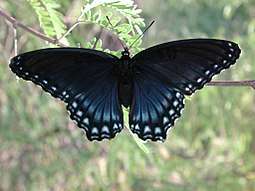
The red-spotted purple butterfly, also known as the subspecies L. arthemis astyanax, is a well known Batesian mimic.[1] The palatable red-spotted purple mimics the unpalatable Pipevine swallowtail (Battus philenor) with its overall dark wings with bright iridescent blue along the hind wings.[1]
The two subspecies differ in the presence of a bright white band on both upper wings in the L. arthemis arthemis (non-mimic form).
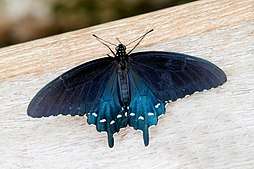
A study hypothesized that the higher density of either model or mimic would cause a decrease in the effect of the mimicry in evading predators; however, this was not the case. The study showed that even with the lowest density of the model, the effectiveness of evading predators by the mimics did not decline.[10]
Another study ruled out a major hypothesis stating that the reappearance of the non-mimic form was due to the evolutionary loss of mimicry and a reversion to the ancestral phenotype.[1] It showed that this hypothesis is most likely incorrect. These reasons included such significant levels of both contemporary and historical gene flow between the two phenotypic species that individual gene trees would not be accurate.[1] In addition, much past work on this hypothesis utilized mitochondrial DNA, which is an unreliable guide to phenotype.[1]
Genetics
Subspecies
Red: L. a. arthemis
Orange: L. arthemis astyanax
Yellow: Hybridization region between L. a. arthemis and L. a. astyanax
Green: L. a. arizonensis
- Limenitis arthemis arthemis, the American white admiral, has the common appearance described in the description section of the white admiral.
- Limenitis arthmeis astyanax, the western American white admiral, has the common appearance of the red-spotted purple.
- Limenitis arthemis rubrofascitata have a brick-red band along the margins of the ventral hindwing, and are mainly found west of Lake Superior.
- Limenitis arthemis arizonensis, the red-spotted purple or red-spotted admiral, have wings that appear similar to the L. a. astyanax, but have pointier hindwings. This subspecies resides in the southwestern regions of the US.
Hybridization
L. arthemis is one of the most dramatic examples of hybridization within a nominal species. The two major subspecies that dominate the hybridization are L. a. arthemis (white admiral) and L. a. astyanax (red-spotted purple). The white admiral is characterized by a bright, white band on its wings, while the red-spotted purple lacks the white band, but has cooler blue-green shades on its wings. Hybridization occurs between a narrow area across New England, southern Ontario, and the Great Lakes, also known as the "suture region". It is at these regions that the subspecies were formed.[8][10]
According to one study, these hybrid zones were of secondary origin, meaning that both the white admiral and the red-spotted purple are already genetically distinct and the two diverged lineages reconnect at this hybrid area.[8] They were able to support their claim by examining various of mitochondria DNA of the population to determine the similarities and differences of the origins of the hybrid zones and the evolution of mimicry. Another study suggests that hybridization is highly frequent in this species because similar species mate together regardless of being the same butterfly or not. For instance, the L. arthemis was found to be mating with a L. archippus butterfly in New England.[11]
Mating
Mate searching behavior
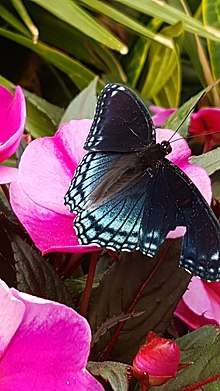
When males are searching for female mates, they tend to seek territories plentiful of the number of visits the females make to that specific area. Mate-locating behaviors for males tended to start in the afternoon, between 11 am and 4 pm. Most males perched as a sign of defense of the territory. Males tend not to favor perching on host trees, but rather on various of foliage like maple, elm trees, or raspberry bushes, generally about 1–2 meters off the ground. This particular mating behavior seems ironic because males should want to perch on host trees as females tend to seek mates in areas where resources like food or host trees are bountiful. Therefore, many times, males are defending areas that do not consist of the most females.[7]
Male-male behavior
Males tend to aggressively fight with each other during territorial fights. Fights last some 1 to 5 minutes.
Female-male behavior
Once a female lands on a leaf, the male lands behind her quite shortly after. If the female does not want to copulate, she closes her dorsal wings.
Ecology
Preferred host plants: birches, including Betula lenta; Salicaceae, including Salix bebbiana and Populus tremuloides, and Prunus virginiana (Rosaceae).
Also but not as often: Crataegus, Amelanchier, Malus pumila, Prunus pensylvanica and Prunus serotina (Rosaceae), Populus deltoides, P. grandidentata and P. balsamifera (Salicaceae), Alnus rugosa, Betula alleghaniensis and Carpinus caroliniana (Betulaceae), Ulmus americana (Ulmaceae), Tilia americana (Malvaceae) and Fagus grandifolia (Fagaceae).
Etymology
Limenitis (New Latin "of harbours", from Ancient Greek Λιμενιτις (from λιμήν, a harbour, haven) – an epithet of Artemis, goddess of the hunt and the wild) – arthemis, from Artemis.[12]
In popular culture
The white admiral (Limenitis arthemis arthemis) is, since a poll in October 1998, the (unofficial) insect emblem of the province of Quebec, Canada. (See Quebec symbols and emblems for further details). It is the only sub-species of Limenitis arthemis present in Quebec.
Image gallery
 Caterpillar
Caterpillar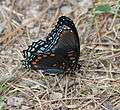 Side view of Limenitis arthemis astyanax, Hot Springs National Park, Arkansas, United States
Side view of Limenitis arthemis astyanax, Hot Springs National Park, Arkansas, United States Back view of Limenitis arthemis astyanax, Hot Springs National Park, Arkansas, United States
Back view of Limenitis arthemis astyanax, Hot Springs National Park, Arkansas, United States White admiral in southern Maine
White admiral in southern Maine Red-spotted purple (Limenitis arthemis astyanax), Baltimore, Maryland, United States
Red-spotted purple (Limenitis arthemis astyanax), Baltimore, Maryland, United States Limenitis arthemis arthemis, New Brunswick, Canada
Limenitis arthemis arthemis, New Brunswick, Canada White admiral in Saskatoon, Saskatchewan, Canada
White admiral in Saskatoon, Saskatchewan, Canada Red-spotted purple (Limenitis arthemis astyanax), Pennsylvania, United States
Red-spotted purple (Limenitis arthemis astyanax), Pennsylvania, United States Limenitis arthemis arthemis, dorsal, Ottawa, Ontario
Limenitis arthemis arthemis, dorsal, Ottawa, Ontario Limenitis arthemis arthemis, ventral, Ottawa, Ontario
Limenitis arthemis arthemis, ventral, Ottawa, Ontario- Limenitis arthemis arthemis, Quebec
 Red-spotted purple, Massachusetts, United States
Red-spotted purple, Massachusetts, United States
References
- 1 2 3 4 5 6 Savage, Wesley K.; Mullen, Sean P. (2009). "A single origin of Batesian mimicry among hybridizing populations of admiral butterflies (Limenitis arthemis) rejects an evolutionary reversion to the ancestral phenotype". Proceedings of the Royal Society B: Biological Sciences. 276 (1667): 2557–65. doi:10.1098/rspb.2009.0256. PMC 2686656. PMID 19369265.
- 1 2 3 Scudder, Samuel H (1889). The butterflies of the eastern United States and Canada: with special reference to New England. OCLC 768299076.
- 1 2 3 Rick Cech and Guy Tudor (2005). Butterflies of the East Coast. Princeton University Press, Princeton, NJ. ISBN 0-691-09055-6
- 1 2 Jim P. Brock and Kenn Kaufman (2003). Butterflies of North America. Houghton Mifflin, New York, NY. ISBN 0-618-15312-8
- ↑ David C. Iftner, John A. Shuey, and John V. Calhoun (1992). Butterflies and Skippers of Ohio. College of Biological Sciences and The Ohio State University. ISBN 0-86727-107-8
- ↑ Wisconsin Butterflies.org
- 1 2 Lederhouse, MI (1993). "Territoriality along flyways as mate-locating behavior in male Limenitis arthemis (Nymphalidae)". Journal of the Lepidopterists' Society. ISSN 0024-0966.
- 1 2 3 Mullen, Sean P; Dopman, Erik B; Harrison, Richard G (2008). "Hybrid Zone Origins, Species Boundaries, and the Evolution of Wing-Pattern Diversity in a Polytypic Species Complex of North American Admiral Butterflies (Nymphalidae: Limenitis)". Evolution. 62 (6): 1400–17. doi:10.1111/j.1558-5646.2008.00366.x. PMID 18331459.
- ↑ Fullard, James H; Napoleone, Nadia (2001). "Diel flight periodicity and the evolution of auditory defences in the Macrolepidoptera". Animal Behaviour. 62 (2): 349–68. doi:10.1006/anbe.2001.1753.
- 1 2 Ries, Leslie; Mullen, Sean P (2008). "A Rare Model Limits the Distribution of Its More Common Mimic: A Twist on Frequency-Dependent Batesian Mimicry". Evolution. 62 (7): 1798–803. doi:10.1111/j.1558-5646.2008.00401.x. PMID 18410533.
- ↑ Covell, Charles V. (1994). "Field observations of matings between female Limenitis archippus and male L. arthemis subspecies (Nymphalidae)". Journal of the Lepidopterists' Society. 48. ISSN 0024-0966.
- ↑ The Century Dictionary by The Century Company. Available online at dictionary.com/index.html.
Literature
- Darby, Gene (1958). What is a Butterfly. Chicago: Benefic Press. p. 37.
- Fullard, James H; Napoleone, Nadia (2001). "Diel flight periodicity and the evolution of auditory defences in the Macrolepidoptera". Animal Behaviour. 62 (2): 349–68. doi:10.1006/anbe.2001.1753.
- Handfield, Louis (1999): Papillons du Québec. Broquet. ISBN 2-89000-486-4
- Lederhouse, R.C., 1992. Territoriality along flyways as mate-locating behavior in male limenitis arthemis. Journal of the Lepidopterists' Society., 47(1), pp. 22–31.
- Covell, Charles V. (1994). "Field observations of matings between female Limenitis archippus and male L. arthemis subspecies (Nymphalidae)". Journal of the Lepidopterists' Society. 48. ISSN 0024-0966.
- Mullen, Sean P; Dopman, Erik B; Harrison, Richard G (2008). "Hybrid Zone Origins, Species Boundaries, and the Evolution of Wing-Pattern Diversity in a Polytypic Species Complex of North American Admiral Butterflies (Nymphalidae: Limenitis)". Evolution. 62 (6): 1400–17. doi:10.1111/j.1558-5646.2008.00366.x. PMID 18331459.
- Ries, Leslie; Mullen, Sean P (2008). "A Rare Model Limits the Distribution of Its More Common Mimic: A Twist on Frequency-Dependent Batesian Mimicry". Evolution. 62 (7): 1798–803. doi:10.1111/j.1558-5646.2008.00401.x. PMID 18410533.
- Savage, Wesley K.; Mullen, Sean P. (2009). "A single origin of Batesian mimicry among hybridizing populations of admiral butterflies (Limenitis arthemis) rejects an evolutionary reversion to the ancestral phenotype". Proceedings of the Royal Society B: Biological Sciences. 276 (1667): 2557–65. doi:10.1098/rspb.2009.0256. PMC 2686656. PMID 19369265.
- Savela, Markku (2008): Markku Savela's Lepidoptera and Some Other Life Forms - Limenitidinae. Version of 31 August 2008.
- Scudder, Samuel H (1889). The butterflies of the eastern United States and Canada : with special reference to New England. OCLC 768299076.
External links
| Wikimedia Commons has media related to Limenitis arthemis. |
| Wikispecies has information related to Limenitis arthemis |
- Red-Spotted Purple: Reference large format diagnostic photographs from Cirrus Digital Imaging
- White Admiral
- Life cycle with photographs of the red-spotted purple (Limenitis arthemis astyanax).
- Pictures of the different subspecies from *Discover Life.
- Limenitis arthemis at Animal Diversity Web
- red-spotted purple on the UF / IFAS Featured Creatures Web site
- White Admiral, Red-spotted Purple, Butterflies of Canada
| Wikispecies has information related to Lepidoptera |
| The Wikibook Dichotomous Key has a page on the topic of: Lepidoptera |
